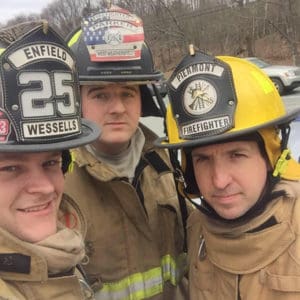By Curt Peterson
In January, 33 area volunteer firefighters will earn their Level I certification by passing a 100-question written exam, and by demonstrating at five “practical stations” that they know how to use equipment, gear and ladders, and how to tie knots necessary for safe firefighting work. The accreditation will be the end of months of training at the Hartland Fire House.
Sunday they received their “Level I Burn” training at the Fire Academy in Pittsford, including practical use of gear and equipment they use in a real fire situation.

Three local graduates from the training program in Hartland that took place in 2016. The next course is in January.
“Students will have invested 180 hours of training that began in August,” Lt. Alan Beebe, 55, a certified firefighting instructor, told the Mountain Times. “And they’re unpaid volunteers, some traveling a distance and sacrificing family time to get their training.”
Beebe said small town fire departments are experiencing a serious shortage of volunteer personnel, and he hopes training new firefighters will help. Members of this class come from various towns — four from Hartland, and others from Windsor, West Windsor, Bridgewater and Ascutney in Vermont, and Canaan and Enfield in New Hampshire. He has trained people from Killington in the past.
There are about 12 women in the group Beebe is training now. Two of the Hartland trainees are women.
“It’s a national program called Pro-Board Certification,” Beebe explained. “People from other states can come to Vermont for classes, and vice versa.”
Students usually begin by volunteering as support for local departments, Beebe said. Without certified training they aren’t allowed to enter a burning building, for example. If they like volunteering, they sign up for the training sessions. There are six or seven in different locations every year.
When Beebe is running a program he draws on a pool of supporting instructors who live all over the state.
This session might have been in Springfield, but Hartland won the opportunity. The program is totally funded by the Vermont Department of Public Safety.
“That was great for me,” Beebe said. “It saved me having to drive to Springfield two evenings a week to teach.”
Forty-two students began the course in August, but only 33 remain.
Beebe said, “Things come up, such as work, family commitments, illness, that cause a student to drop out.”
Whatever portion of the training a student has completed can be carried over to a future program if they want to rejoin classes at a later date.
Twenty of the 33 new Level I firefighters are planning to continue training for Level II certification, Beebe said. That means another 50 class hours and final testing in April.
The Level II burn class in January involves, in part, learning the Infinite Command System (ICS), radio communications the fire fight leader — usually the local chief or another officer — uses to manage the scene.
“If you have a structure fire,” Beebe explained, “no small town fire department can handle it alone, so multiple towns participate. There can be 10 to 60 people you’re managing, so knowing how to use and respond to ICS is really important.”
The Level II students also learn how to deal with any hazardous materials at a fire site.
Beebe was a full-time firefighter and EMT for the town of Hartford for 18 years. He said when he applied for that job, there were 50 other applicants. Today, they are lucky if they receive more than one. In his time in Hartford, Beebe knew only a half-dozen firefighters who went on to build careers in the field.
“I don’t understand it,” he said. “It’s the greatest job in the world.”
The quality of a town’s local fire department helps determine the cost of local property insurance. Training firefighters can have an effect.
“Factors include speed of a department’s response, how much water they have available, and the level of training the volunteers have,” Beebe said.




